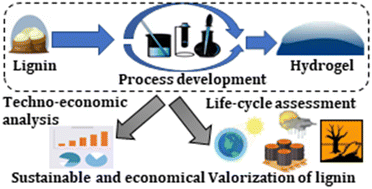System-level integrative analyses for production of lignin hydrogels†
Abstract
Rapid population growth and industrialization have pressed the search for alternative sources to synthesize biomaterials. In this venture, this manuscript deals with process development for the synthesis of a lignin hydrogel (LH) which has biomedical applications viz., wound healing, etc. Two different synthesis strategies have been studied: single and two-step processes and likely categorized as grade A and B LHs, respectively. These strategies have been considered to study the role of the raw material (native vs. methacrylated lignin) on the overall technoeconomic analysis (TEA) and life-cycle assessment (LCA) of the process. The minimum selling price (MSP) of LH grades A and B has been estimated to be 2774 US$ per ton and 4489 US$ per ton, respectively, and have been observed to corroborate with the market price range of wound dressing gels. A “hydrogel production” sub-system has been observed to be the major contributor towards the MSP of LH due to the use of costly monomers in polymerization. Sensitivity analysis was conducted to find out parameters having a significant influence on MSP. Uncertainty analysis was also carried out to study the influence of market uncertainties on the MSP of LH. From the LCA study, it was estimated that the grade A hydrogel production process is comparatively cleaner than that of grade B. Overall, the proposed strategy of lignin upgradation can be integrated within the lignocellulosic biorefinery in future studies for the development of eco-friendly processes.



 Please wait while we load your content...
Please wait while we load your content...